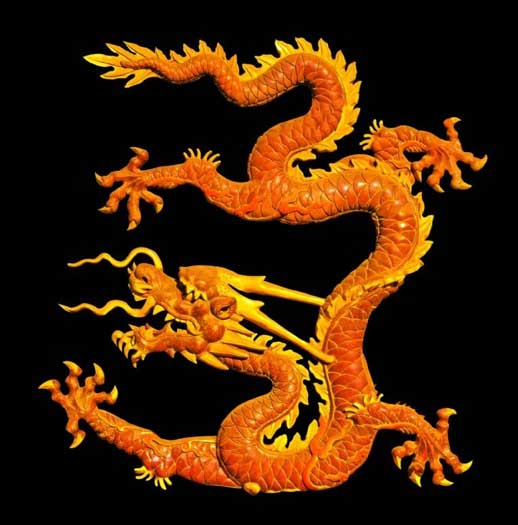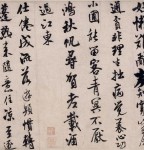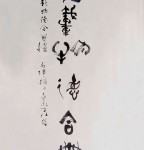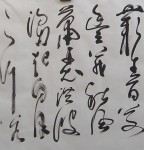Seal Script Chinese Calligraphy - Chinese Dragon
Size: 137cm X 64cm
Calligrapher: Ding Shimei
The Chinese Dragon in Chinese Culture
The Chinese Dragon
Most of us are all to familiar with the classic western concept of the dragon, but not all have a great insight into probably one of the most recognised dragons, the Chinese dragon.
Chinese dragons are legendary creatures in Chinese mythology and folklore, with mythic counterparts among Japanese, Korean, Vietnamese, Bhutanese, Western and Turkic dragons. In Chinese art & culture, dragons are typically portrayed as long, scaled, serpentine creatures with four legs. In yin and yang terminology, a dragon is yang and complements a yin fenghuang "Chinese phoenix".
In contrast to European dragons, which are considered evil, Chinese dragons traditionally symbolize potent and auspicious powers, particularly control over water, rainfall, hurricane, and floods. The dragon is also a symbol of power, strength, and good luck.
In Chinese daily language, excellent and outstanding people are compared to the dragon while incapable people with no achievements are compared with other, disesteemed creatures, such as the worm. A number of Chinese proverbs and idioms feature references to the dragon, for example: "Hoping one's son will become a dragon" (望子成龍, i.e. be as a dragon).
Symbolic value
Historically, the dragon was the symbol of the Emperor of China. In the Zhou Dynasty, the 5-clawed dragon was assigned to the Son of Heaven, the 4-clawed dragon to the Zhuhou (seigneur), and the 3-clawed dragon to the Daifu. In the Qin Dynasty, the 5-clawed dragon was assigned to represent the Emperor while the 4-clawed and 3-clawed dragons were assigned to the commoners. The dragon in the Qin Dynasty appeared on national flags.
The dragon is sometimes used in the West as a national emblem of China. However, this usage within both the People's Republic of China and the Republic of China on Taiwan as the symbol of nation is not common. Instead, it is generally used as the symbol of culture. In Hong Kong, the dragon is part of the design of Brand Hong Kong, a symbol used to promote Hong Kong as an international brand name.
In European-influenced cultures, the dragon has aggressive, warlike connotations and it is conjectured that the Chinese government wishes to avoid using it as a symbol, but most Chinese disagree with this decision. Westerners only sometimes confuse the disposition of the benevolent Chinese dragon with the aggressive Western dragon.Many Chinese people often use the term "Descendants of the Dragon" (simplified Chinese: 龙的传人; traditional Chinese: 龍的傳人; pinyin: lóng de chuán rén) as a sign of ethnic identity, as part of a trend started in the 1970s when different Asian nationalities were looking for animal symbols for representations. The wolf was used among the Mongols, the monkey among Tibetans.
In Chinese culture today, the dragon is mostly used for decorative purposes. It is a taboo to disfigure a depiction of a dragon; for example, an advertisement campaign commissioned by Nike, which featured the American basketball player LeBron James slaying a dragon (as well as beating up an old Kung Fu master), was immediately banned by the Chinese government after public outcry over disrespect.
In Chinese mythology there are five types of dragon:
Those guarding the gods and emperorsThose controlling the wind and rainEarthly dragons which deepened the rivers and seasGuardians of hidden treasureThe first dragonThe First dragon appeared to the mythical emperor Fu-hsi, and filled the hole in the sky made by the monster Kung Kung. Its waking, sleeping and breathing determined day and night. Season and weather.
There are many differences between the classical dragon and the Chinese dragon, these include the ability to fly even without wings, shape-shifting abilities, and of course the general benevolent behaviour to the populace.
The Chinese dragon is made up of nine entities. The head of camel, the eyes of a demon, the ears of a cow, the horns of a stag, the neck of a snake, it's belly a clam's, it's claws that of an eagle, while the soles of his feet are that of a tiger, and the 117 scales that cover it's body are that of a carp.
The Chinese dragon has four claws as standard, but the Imperial dragon has five, this is to identify it above the lesser classes. Anyone other than the emperor using the 5 claw motif was put to death.
The Chinese dragon (Lung) was a divine bringer of rain, necessary for the good of the people. Throughout Chinese history the dragon has been equated with weather. It is said that some of the worst floodings were caused when a mortal has upset a dragon. The dragon was also a symbol of the emperor whose wisdom and divine power assured the well-being of his subjects. Many legends draw connections between the dragon and the emperor. Some emperors claimed to have descended from the dragon.
Chinese dragons of myth could make themselves as large as the universe or as small as a silkworm. They could also change color and disappear in a flash. They rise to the skies in the spring and plunge into the waters in the autumn.
Ancient China Dragon occupies a very important position in Chinese mythology. It shows up in arts, literature, poetry, architecture, songs, and many aspects of the Chinese conscience. The origin of Chinese dragons is unknown, but certainly pre-dates the written history.
Nine Dragon Wall A very popular tourist site in Beijing is this Nine-Dragon Wall in BaiHai Park. After hundreds of years, the colours of the ceramic tiles are just as brilliant. The wall was built in 1756. It is 21m long, about 15m high and i.2m thick. It is faced with 424 7-colour ceramic tiles. At the centre of the wall, there is a giant dragon, flanged by four dragons on each side. In addition to these nine large dragons, the wall is covered from edge to edge with many smaller dragons. In all, there are 635 dragons.
According to legend the Dragon had nine sons, and each had a strong personality. There is no general agreement as to what the Dragon's sons are called. However, to most people, they are:
1.Haoxian A reckless and adventurous dragon whose image can be found decorating the eaves of palaces. 2.Yazi Valiant and bellicose; his image is seen on sword-hilts and knife hilts. 3.Chiwen Chiwen likes to gaze into the distance and his appearance is often carved on pinnacles. 4.Baxia Baxia is a good swimmer and his image decorates many bridge piers and archways. 5.Pulao Pulao is fond of roaring and his figure is carved on bells. 6.Bixi Bixi is an excellent pack-animal whose image appears on panniers. 7.Qiuniu Qiuniu loves music and his figure is a common decoration on the bridge of stringed musical instruments. 8.Suanmi Suanmi is fond of smoke and fire; his likeness can be seen on the legs of incense-burners. 9.Jiaotu Jiaotu is as tight-lipped as a mussel or a snail. His image is carved on doors.
Awakening the Dragon by Shelagh Pierce
The Chinese dragon boat races will always be a symbol of Chinese culture and spirit. As one of the three largest Chinese festivals of the year, this mythical celebration can now be witnessed around the world. To experience a dragon boat race - either watching or participating - is a thrill in itself and can be enjoyed by everyone.
You'll watch as long, multicoloured boats, with frightening dragons' heads, long tails, and scaly bodies, splash through the water. You'll see men, women, and children grunt and sweat as they push themselves harder and faster to be the first to the finish line. You'll hear the crowds screaming and cheering for their favourite team, while the drummers pound on their drums and yell at the paddlers. The event is not intended to be quiet and peaceful but loud and exciting - a celebration!
To observe the Chinese dragon boat races of today, you can only dream of its meagre beginnings. A time when superstition determined how a person lived. In fact, dragon boat racing began more than 2000 years ago when a group of superstitious people believed that the boat racing would ensure prosperous and bountiful crops. Their celebrations took place on the summer solstice - the time of year typically associated with disease and death and when man felt most helpless against the powers of nature. The race has come to symbolise both man's struggle against nature and his fight against dangerous enemies.
The tragic tale of Ch'u Yuan further integrated the dragon boat races into the lives of the Chinese. Fourth Century B.C.E. is known as the period of the "warring states" in Chinese history. It was a time when numerous supremacy wars between feudal lords erupted. Many kingdoms had already disappeared, except for Ch'u, which was one of the mightiest kingdoms remaining. Ch'u Yuan was a poet and a minister and councillor to the king of Ch'u - truly a great patriot. He feared for the future of his kingdom and to do the best for his country, he gave advice to the king. To his surprise, the advice was not accepted and he was exiled. At the devastation of the kingdom of Ch'u and his exile, Ch'u Yuan, in desperation and sorrow, threw himself into the Mi Lo river.
The people of Ch'u loved Ch'u Yuan. They grieved over his death and spent much time trying to scare the fish and water dragons away from Ch'u Yuan's body by rowing around the river in their fishing boats, splashing their oars, and beating their drums. And to ensure that Ch'u Yuan never went hungry, they wrapped rice in leaves and threw them into the river. Rice cakes are still eaten today as part of the dragon boat festival celebration.
The dragon boat festival is typically celebrated "the Fifth of the Fifth" - the fifth day of the fifth month. Red is the prominent colour on the boats because it is the colour of the number five and symbolises heat, summer, and fire. The lengths of the boats can range between 30 and 100 feet but are wide enough to barely fit two people side by side. Some of the original rituals are still practiced today, like the "Awakening of the Dragon" by dotting the eyes of the dragon's head on each boat. This ceremony is conducted to cleanse and bless the area of the competition, the competitors, and their boats. It also gives the boats and their crew the strength of the Dragon and the blessing of the Goddess of the Sea.
Nevertheless, much has changed in the festival. The crowd no longer throws stones at the rival boats and it is not imperative a boat capsize and at least one person drown - which was considered a special sacrifice to the gods and was, surprisingly, a sign of good luck.
Today the dragon boat races are primarily a form of amusement. It is no longer a necessary ceremony performed to scare away evil and call for a good year but entertainment that teaches people a little about Chinese history and culture. We are not nearly as superstitious as we were in the past but it sure is fun pretending!
The Dragon in Oriental Mythology
In the mythology of various Oriental countries, notably Japan and China, the dragon is the supreme spiritual power, the most ancient emblem in Oriental mythology and the most ubiquitous motif in Oriental art. Dragons represent celestial and terrestrial power, wisdom, and strength. They reside in water and bring wealth and good luck and, in Chinese belief, rainfall for crops. The dragon in traditional Chinese New Year's Day parades is believed to repel evil spirits that would spoil the new year. The five-clawed dragon became the Chinese Imperial emblem (the four-clawed being the common dragon). The three-clawed dragon is the Japanese dragon. In Hindu mythology, Indra, god of the sky and giver of rain, slays Vitra, Dragon of the Waters, to release rainfall.
| < Prev | Next > |
|---|
- 2008-09-30 - 丁仕美草书书法中堂《咏五路山》
- 2008-09-24 - Honesty, Pure, Peace. Seal Script
- 2008-09-20 - Upon Cloudland, Cursive Script
- 2008-09-20 - 丁仕美草书书法横幅-释文:江河万古流---中国邮政书法明信片系列
- 2008-09-20 - 丁仕美大篆书法横幅《尚书·大禹谟》释文:野无遗贤,万邦咸宁。-中国邮政书法明信片系列
- 2008-09-20 - 丁仕美大篆书法竖轴-释文:黄河母亲,---中国邮政书法明信片系列
- 2008-09-20 - 丁仕美草书书法中堂-释文:千江有水千江月,万里无云万里天(偈语) --中国邮政书法明信片系列
- 2008-09-20 - 丁仕美草书书法中堂-释文:江河水,---中国邮政书法明信片系列
- 2008-09-20 - Imperial Dragon in Chinese Calligraphy, Big Seal Script Banner
- 2008-09-20 - Expect or Hope in Chinese Calligraphy, Big Seal Script Central Scroll















